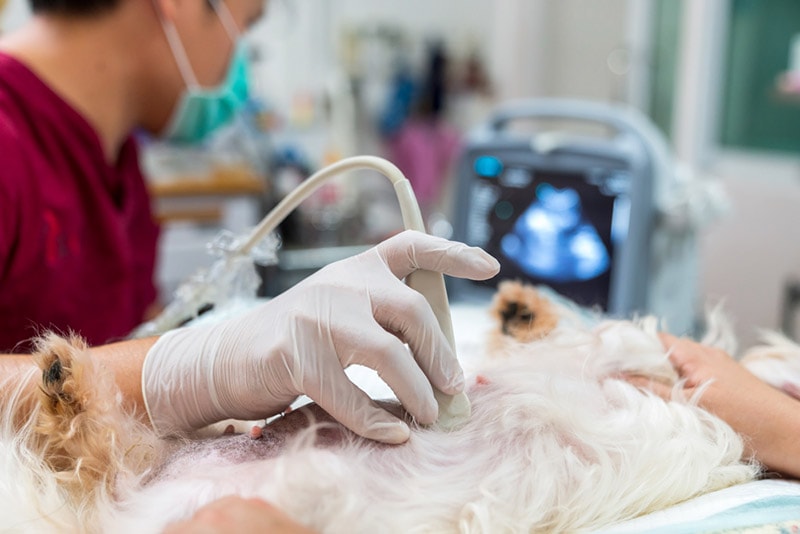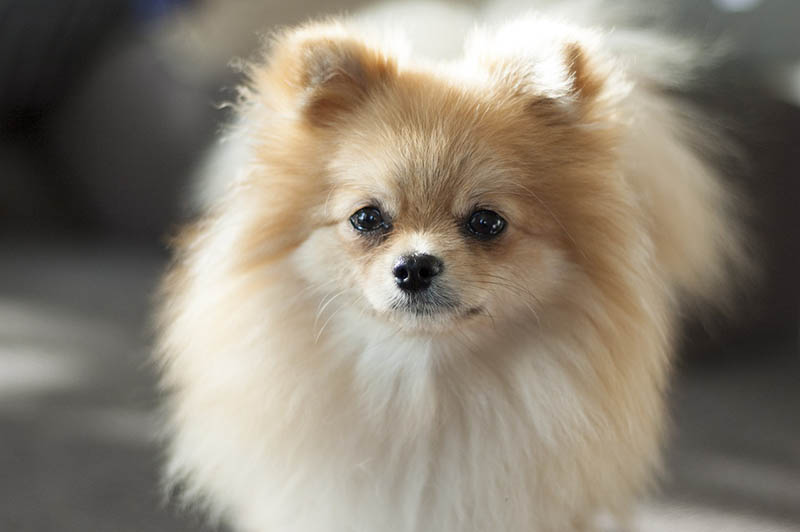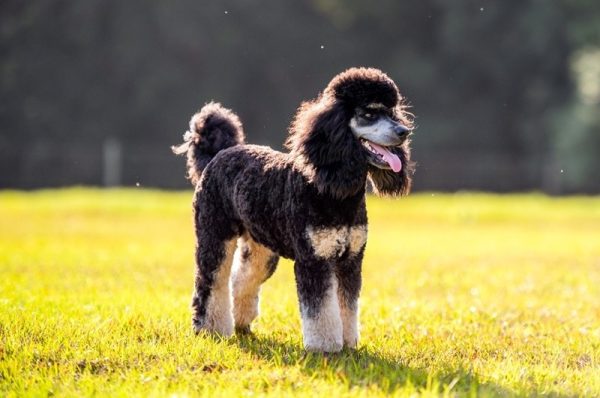In this article
Whether you have a male or female pet, deciding to breed your dog is a serious undertaking. Of course, the risks are greater for the latter, with the possibility of problems during birth. We strongly urge you to get your pup examined before making any plans. Some conditions may exist already that can affect your decision.
Some breeds are more prone to some issues than others. Age is another risk factor. The best ways to prevent reproductive problems are regular veterinary care and a healthy diet suitable for your pet’s life stage and size. We suggest putting these things in place several months before breeding your dog.
We’d be remiss if we didn’t refute a common misconception that all females should have one litter. It’s not necessary for your pet’s health. Likewise, neither is spaying or neutering your pet a given. Some breeds, such as Golden Retrievers, are more prone to develop joint conditions if their sex is altered while they are too young.1 However, working with a vet is imperative for a good outcome.

Female Dog Reproductive Problems

Pregnancy is risky for females, even in the healthiest of pets. There are several possible causes of potential problems, from genetics to bacterial infections to complications after birth. Some are detectable before breeding. Others occur without warning. Knowing your pet’s background can help identify some issues. We strongly recommend pre-breeding health screening.
1. False Pregnancy
A false pregnancy mimics all the signs you’d expect in a real pregnancy. Your dog will look and act as if it’s pregnant. The mammary glands will enlarge, and some dogs will even produce milk. Some pets take it to the extreme by playing mother to their toys. Confirming whether it’s a true or false pregnancy is easy with an X-ray. The treatment is usually symptomatic and may include tranquilizers to relieve anxiety and diuretics to reduce milk production and relieve fluid retention. Some cases will require hormonal treatment.
2. Silent Heat
This term describes a female that doesn’t show outward signs of being in heat or estrus. There isn’t any bleeding or vulvar swelling that you typically see during the typical 14-day cycle. If a male dog shows particular interest in mounting a female and the female is receptive even if she is not showing any signs of heat, chances are this is a silent heat. If they mate, your dog will get pregnant! A veterinarian can investigate whether a female is in heat by measuring progesterone in blood serum and collecting a vaginal swab for cytology.

3. Ovarian Cysts
A telltale sign of this condition is a prolonged heat that surpasses the 21-day mark. Cysts develop as fluid or semi-fluid-filled sacs in the female’s ovaries. Ovulation is unlikely. However, if you intend to breed the dog, pregnancy is still possible by induction using hormonal treatments. Unfortunately, the typical treatment is spaying the dog.
4. Primary Persistent Anestrus
This condition occurs if a pet hasn’t had its first estrus in 2 years. It causes various signs, including hormonal imbalances, malnutrition, and extraneous physical activity. Your vet will run bloodwork and hormone assays to determine a cause. They may order an ultrasound to look for physical reasons. These tests will set the course of treatment.

5. Abortion
Some pets can conceive but will not carry the litter to term. Common causes are diabetes, hormonal imbalances, or infections like Brucellosis. Lab work will provide the necessary information for a diagnosis and treatment.
6. Vaginitis
This term describes a bacterial infection in the dog’s vagina. It triggers an immune response with the typical signs of discharge, redness, and swelling. A female will avoid copulation if it’s painful. Your vet will begin antibiotic treatment by first determining the type of bacteria through lab work and a physical exam.
It’s worth noting that other things can cause this condition, such as trauma, viral infections, or even tumors. It often occurs in puppies before their first estrus. It is often self-resolving in these pets. Other cases will require treatment according to their primary cause.
7. Difficult Birth
Dystocia, or difficult birth, is one of the risk factors of pregnancy that can harm both the mother and her puppies. Physical factors can cause it. That’s one reason we advise against breeding larger dogs with smaller females. The mere size of a pup’s head could cause prolonged labor. Some breeds, such as Boxers, are also prone to this condition.
The female will show evident signs of distress, with excessive licking, discharge, and pain. Veterinary intervention is imperative. They may opt for a conservative approach with medication first before resorting to invasive surgery.

8. Retained Placenta
This condition occurs when the mother doesn’t expel the entire placenta after birth. It represents a significant risk factor for bacterial infections that can ultimately affect the puppies’ survival, too. Treatment involves administering drugs to induce the elimination of any remaining tissue and antibiotics, if necessary. Your vet may also recommend spaying.
9. Uterine Prolapse
The obvious sign of uterine prolapse is a noticeable mass protruding out of your pet’s vagina after giving birth. Veterinarians grade them based on how much is visible. The primary concern is whether it blocks your dog’s urethra and affects its ability to urinate. It’s considered a medical emergency in these cases.
Your vet will treat mild cases with hormones so that they can self-resolve. More serious situations require surgery and follow-up care. You may also have to spay your dog to prevent further problems.
If you need to speak with a vet but can't get to one, head over to PangoVet. It's our online service where you can talk to a vet online and get the advice you need for your pet — all at an affordable price!
10. Metritis
Metritis is a bacterial condition of the uterus caused by risk factors of a difficult birth, such as a retained placenta. If left untreated, it will present with infection signs, including fever and lethargy. It also risks the puppies if the female is too painful to care for its young.
Treatment may include bacterial culture, antibiotic treatments, and supportive care for the female. Your vet will also treat any other underlying cause.

11. Mastitis
Mastitis or inflammation of the mammary glands occurs after birth. It describes a bacterial infection caused by physical damage to the teats by the puppies or unclean living quarters. The signs are typical of what you’d see in similar conditions. They include redness, swelling, and warmth. It can become serious if left untreated.
Treatment typically includes antibiotics and supportive care with warm compresses. Your vet may also recommend that you feed the pups to give your pet a chance to heal.
12. Infertility
You should suspect infertility if your dog has failed to conceive after several breeding attempts. Several things can cause it, from genetics to infections to irregular cycles. Your vet will begin with a physical examination and bloodwork to determine the cause and treatment.

Male Dog Reproductive Problems

Male dogs are also at risk of some reproductive issues, even if you don’t breed them. Unlike female problems, many have nothing to do with mating at all. Some are short-term conditions caused by pathogens or disease-causing organisms. Others are genetic and require different treatments.
13. Cryptorchidism
Cryptorchidism describes a condition in which one or both testicles don’t descend from the abdominal cavity into the scrotum. It normally occurs by the time the dog has reached sexual maturity. While a pet can still mate with a female one, breeders typically will not breed these animals since it is a genetic disorder.
If both didn’t descend, the male is sterile. Smaller toy and miniature breeds are most prone to this condition. There is also a heightened risk of testicular cancer in these animals.

14. Phimosis
The classic sign of phimosis is the failure of the dog’s penis to emerge from the prepuce. While the pup may show normal mating behavior, it cannot mate with the female. Several things can cause it to occur, from bacterial infections to injury to genetics. Sometimes, phimosis caused by a narrow opening in the sheath can interfere with urination and lead to infections or blockages. In this case, your dog will require surgery to widen the opening of the sheath.
15. Balanoposthitis
Balanoposthitis is an infection that affects both the prepuce and the penis. Signs include excessive linking, discharge from the penis, and inflammation. Several things can cause it, such as phimosis, injury, and allergies. Treatment is primarily supportive, with regular grooming of the area and antibiotics if necessary.
16. Orchitis
Orchitis is a general term describing inflammation of the testicles. Bacterial infections and injury are common causes. Treatment usually includes sedation because of the resulting pain. It will address the underlying cause, using antibiotics if required. Sometimes, it becomes chronic, leaving a pet infertile. Unfortunately, the prognosis is poor in these cases; castration is the treatment of choice.
17. Paraphimosis
Paraphimosis is the opposite of phimosis, where the penis can not return into the prepuce after mating. Unlike the latter, this condition is a medical emergency that requires immediate treatment. If the condition is prolonged, the penis will become swollen, and the mucosa will be dry and painful. Surgery might be necessary in severe cases.


Final Thoughts
It’s essential to consider the risks before breeding your dog. After all, some reproductive problems exist with both female and male pets, as you’ve seen. Unfortunately, many go unnoticed until you’ve made that decision. Interestingly, spaying or neutering is often a part of the treatment plans for several of these conditions.
The takeaway message is that regular veterinary care and a healthy, high-quality diet are critical to the health of your best friend, no matter if you choose to breed it or not. It’s the single best thing you can do to ensure a good quality of life for your pet.
Related reads:
Featured Image Credit: Ermolaev Alexander, Shutterstock




















